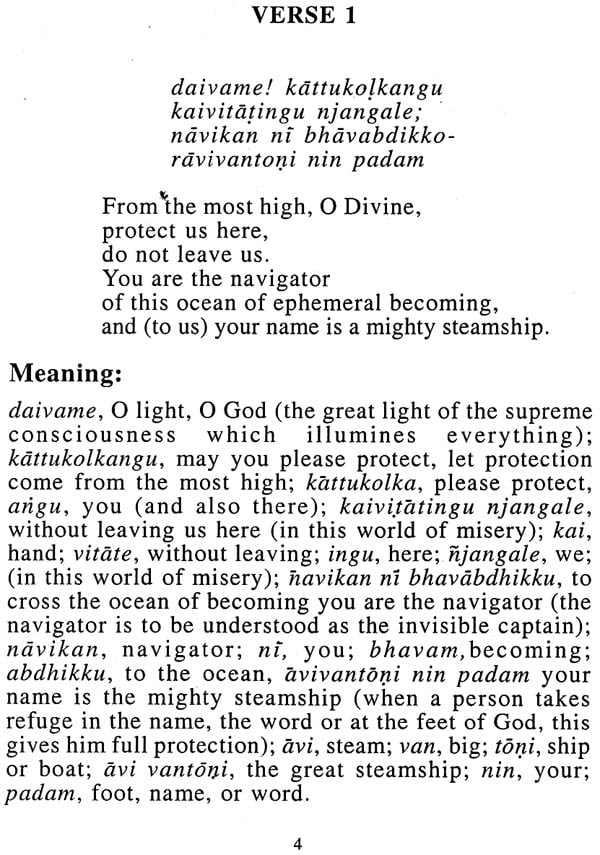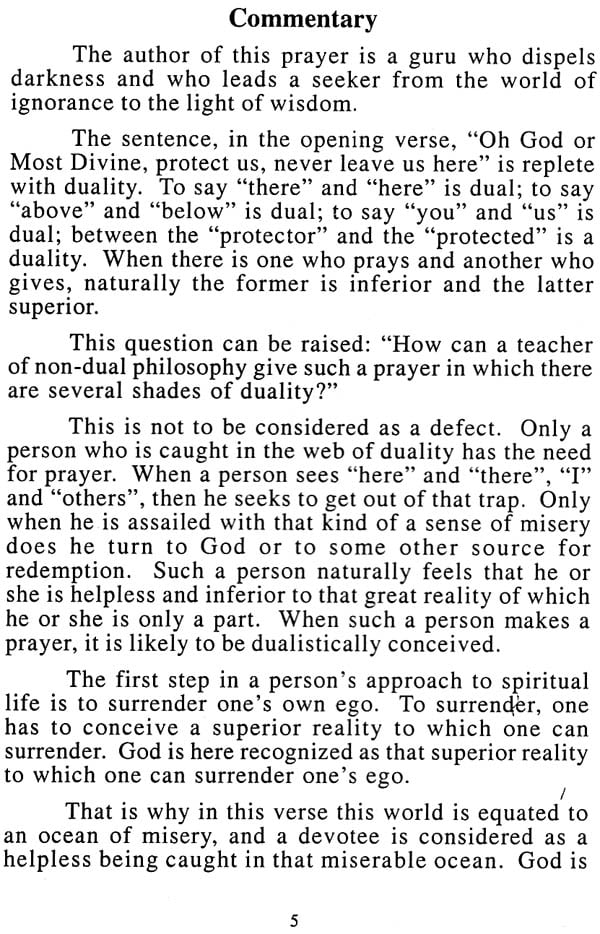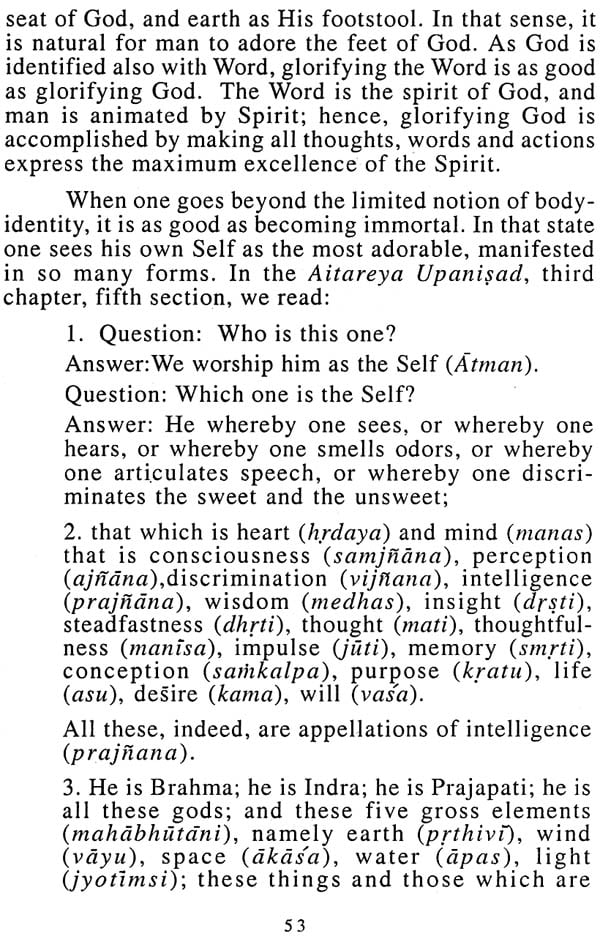
Daiva Dasakam (The Universal Prayer)
Book Specification
| Item Code: | NAU773 |
| Author: | Nitya Chaitanya Yati |
| Publisher: | Narayana Gurukula, Kerala |
| Language: | English |
| Edition: | 2014 |
| Pages: | 60 |
| Cover: | PAPERBACK |
| Other Details | 7.00 X 5.00 inch |
| Weight | 70 gm |
Book Description
Is there a God? Is this world real, or is it only a shadow? Does human life have any purpose? To all these questions, different answers can be given from different points of view.
In the animals of the forest, the fish of the sea and in the vegetative world, we see one and the same life. It is not different from human life. To exist, to be horn, to grow, to change, to decay and finally to perish is the common lot of all living organisms. In that, man is not different from a worm. To say that our life has a greater meaning than that of a blade of grass does not have much pertinence on the biological level.
Although nature has not given any special goal to human life, man can propose a goal for himself. He can make his life purposive by developing his own life-philosophy. Family life, national life, social life – all these are upheld as human history. These are as real as the physical world in which we live.
However, these institutions are all built on traditional concepts and mere ideas, which came from human minds. Social contracts to which man submits himself, and international conventions to which nations agree, are all born of the human mind. They are mere ideas. Thus, in our world, facts and ideas stand on a par in terms of their influence on our lives.
According to the Indian tradition, it is believed that man has four main goals in life. They are dharma, acquiring righteousness; artha, earning livelihood; kama, fulfilling desires; and moksa, attaining realization. Of these four, realization is considered to be the final goal of life. For this reason, it is called paramapurusartha.
Devotion is considered to be the best of all tools for realization. In Sankara’s great work Vivekacudamani, he says that of all the instruments for realization, nothing is more efficient than bhakti or devotion. In Narayana Guru’s Darsana Mala, also bhakti is given a very high place.
The realization that one gains by resorting to bhakti has five aspects. They are: saranagati, surrendering oneself absolutely to the Divine; stuti, praising the Absolute or praising God; dhyathru dheya parasparya, cultivating a bipolarity between the meditating person and that which is meditated upon, as for instance in the a bipolarity between man and God. The fourth is arthana, praying, making requests. The final one is santi, the peace that one gets by disciplining oneself this way.
Thus, is is called pancanga laksana, a devotion which has five characteristic marks. Panca means five; anga means limbs; laksana means marks.
Daiva Dasakam is a prayer which has all these five principles implied in it. Out of compassion, Narayana Guru composed this prayer for his disciples. Nowadays, in the morning and evening hours, one can hear this prayer being recited in many homes in South India.
Narayana Guru is a prophet of this new age in which science and the freedom of man have become of great importance to mankind. In this prayer, he has kept his thought as close as possible to the language of modern man. He does not parochially limit his concepts to any particular place or time.
The Guru is part of the traditional hierarchy of Vyasa, Suka, Yajnavalkya and the other great Gurus of the Upanisadic tradition. For this present commentary, I am indebted to my guru, Nataraja Guru. I am grateful to him for the grace which he is always showering upon me.
Life can be approached from three angles: philosophy, religion and science. Philosophy is the path for those who can infer realities by putting together facts, mentally coordinate data to get an organized picture, and who also have an intuition to look at the hidden meanings of life which are not revealed through the perceptual data of everyday experience. Religion places its emphasis more on the heart, the feelings, of man. From this angle mystical experiences have a great place. Devotion is relevant to religion. Science is the path for those people who want to have a factual assessment of the given world and put their emphasis on the objectivity of what they study. There are branches of science which go beyond this delimitation, such as the study of human nature through looking at historical facts with critical acumen. These branches still come under the category of science.
It is difficult to place Narayana Guru in any single one of these categories. His approach is of a philosopher, a religious person and also a scientist. There is nothing of interest which he has left outside the scope of his search and study.
At the emotional level, his life was moved by compassion. He never caused any hurt, even to a little ant. To love all was very basic to him. The secret formula of his life was, "Only he lives who loves (arul ullavandnu jivi)." In social life he never compromised with injustice or inequality. He always fought against any kind of exploitation in which his fellow beings indulged.
Thus, in Narayana Guru’s Daiva Dagsakam, we have a prayer which can be assessed from all the three angles of the philosopher, the religious person and the scientist. It is at once a song and a science.
Prayer is common in Indian literature. The Vedas are supposed to be the oldest of ancient literature, and among the Vedas, the Rg Veda comes first. Except for the Isavasya Upanisad and Gayatri, we do not come across any prayer in Vedic literature which is not addressed to one particular deity, such as Varuna, Mitra, Agni or Indra. We can say that since the time of the Isavdsya Upanisad, Narayana Guru’s prayer is the first universal prayer which has come from an Indian pen. Isavasya Upanisad comes in the Samhitd part of the Yajur Veda, so it can be considered as a Vedic text. However, according to Sankara, it teaches wisdom, so it should be considered as an Upanisad. It is a piece of wisdom literature. Although the Savasya Upanisad begins with addressing God as such, without calling him Varuna, Mitra or Agni, towards the end it closes with special reference to the Sun and Fire as deities.
In the present prayer, only the Absolute is praised throughout. It is not specially aimed at any God of the Hindu pantheon. The sense in which God is recognized in the religions of Judaism, Christianity, and Islam, is not accepted by the six systems which are considered to be the orthodox philosophical schools of India. In traditions such as Saiva, Vaisnava, Sakteya and Ganapatya, there are great lovers of God who have written emotionally charged hymns with great philosophical meaning addressed to Visnu, Siva, Sakti, or Ganapati. But in this prayer we see a departure from all of these traditions.
God is here recognized as one God, not as the God of any place or religion. That Absolute is related with everything that depends on the Supreme.
**Contents and Sample Pages**









